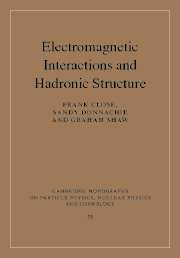Book contents
- Frontmatter
- Contents
- List of contributors
- Preface
- 1 Quark models of hadrons and issues in quark dynamics
- 2 Elastic form factors
- 3 Electromagnetic excitations of nucleon resonances
- 4 Meson radiative decays
- 5 Intermediate-energy photoproduction
- 6 Chiral perturbation theory
- 7 Spin structure functions
- 8 Diffraction and colour dipoles
- 9 Generalized parton distributions
- 10 Quark–hadron duality
- 11 Colour transparency
- Index
Preface
Published online by Cambridge University Press: 15 August 2009
- Frontmatter
- Contents
- List of contributors
- Preface
- 1 Quark models of hadrons and issues in quark dynamics
- 2 Elastic form factors
- 3 Electromagnetic excitations of nucleon resonances
- 4 Meson radiative decays
- 5 Intermediate-energy photoproduction
- 6 Chiral perturbation theory
- 7 Spin structure functions
- 8 Diffraction and colour dipoles
- 9 Generalized parton distributions
- 10 Quark–hadron duality
- 11 Colour transparency
- Index
Summary
Within the Standard Model of particle physics, it is the strong phase of QCD that is least understood, and the electromagnetic interaction that is best understood. It is therefore natural to use the electromagnetic interaction as a relatively gentle probe of the internal structure of hadrons and of other aspects of non-perturbative strong interactions.
This approach is hardly new: electron scatteringwas first used to measure the charge distribution within the proton some 50 years ago. However, its importance has been enormously enhanced by the recent development of many experimental facilities dedicated to electromagnetic interactions, and the realization that other laboratories can access electromagnetic interactions in novelways. These facilities are primarily at low and medium energies, which probe the small-Q2 kinematic regions, and upgrades are planned. In contrast, existing high energy electron accelerators, such as HERA, are soon to close, and even B-factories in e+e- annihilation are coming to the end of their lives. The focus of electromagnetic and hadron physics will be on QCD in the strong interaction regime (‘strong QCD’) as distinct from perturbative QCD physics.
The physics of strong QCD falls mainly into two areas: hadron spectroscopy at low energies and non-perturbative aspects of high-energy processes. In spectroscopy, the ability to tune the virtuality of the photon in electroproduction enables the spatial structure of baryons to be explored; and since photons only couple directly to charged particles, they are a vital tool in separating the roles of quark and gluonic degrees of freedom within hadrons, and hence in filtering glueballs and hybrid mesons.
- Type
- Chapter
- Information
- Electromagnetic Interactions and Hadronic Structure , pp. xii - xivPublisher: Cambridge University PressPrint publication year: 2007



